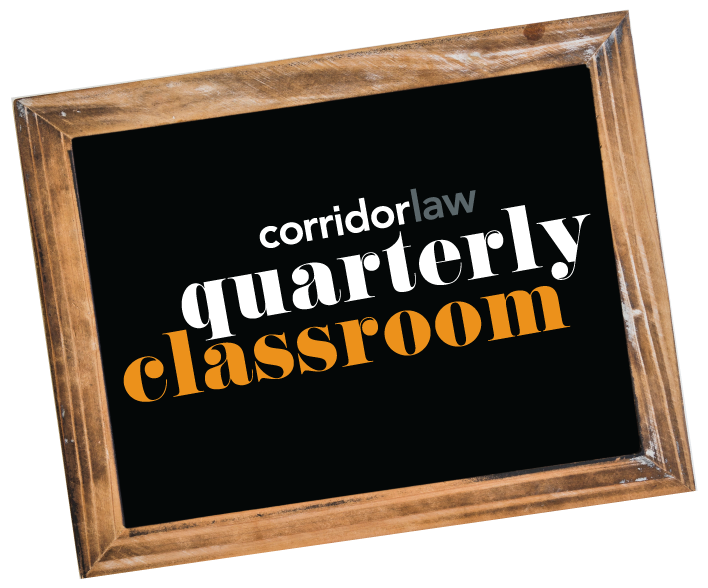Because Real-Time Knowledge is More Useful Than an Annual Review
May 9, 2019
1:00pm – 4:30pm
Downtown Des Moines Holiday Inn
Live Stream Link Available to Watch from Your Conference Room or Desk
Proposed Topics
-
- The New Things You Need to Know About Handling a Shoulder Injury Claim in 2019.
- Impact of §85.34(2) in making a shoulder a scheduled injury and not Body as a Whole.
- Impact of §85.34(2) on limiting scheduled awards to the functional loss rating under the AMA Guidelines and not allow the Agency discretion to rely upon lay testimony or Agency expertise.
- What impact does §85.34(3) have on evaluating exposure for shoulder injuries when there are preexisting or non-industrial sources of pain or limitation.
- How to handle cumulative shoulder injury claims when the cumulative injury forces exist both before and after July 1, 2017.
- What does the new law allow you to apportion out in terms of benefits for pre-existing, non-industrial or subsequent shoulder injuries.
- How to handle alternative theories of injury (cumulative vs. traumatic) in the same case.
- What obligations are created for Vocational Rehabilitation when a permanent shoulder injury occurs.
- Learning How to Apportion out Preexisting or Non-industrial Injuries or Conditions When Evaluating Functional Loss, Impairment and Permanent Restrictions.
- What are the accepted ways of separating and apportioning injuries and disabilities used in other states?
- How important is a pre-injury baseline assessment in apportioning out disability?
- What means are available under the AMA Guidelines or accepted medical causation practices to separate and apportion out disability from pre-existing or non-industrial sources?
- What diagnostic tools are available to determine the specific sources of injury and disability when pre-existing or non-industrial injuries or conditions exist?
- How do you determine the source of an injury or medical condition for assigning permanent restrictions when pre-existing or non-industrial injuries or conditions exist?
- What do the 2017 Legislative Changes Allow in Regard to Accepting or Denying Compensability of a Claim, Authorizing Medical Care, Making Voluntary PPD Payments and Evaluating Industrial Disability when There Exists an Ability to Apportion Out Preexisting or Non-industrial Injuries or Conditions.
- Electrodiagnostic Function Assessment (“EFA”): The Newest Technology in Establishing a Baseline Functioning and Evaluating the Source and Extent of Permanent Injuries in Workers.
- What is EFA and how does a pre-injury and post injury assessment occur?
- How accepted is the science of EFA in the medical community?
- How can EFA be used in apportioning out pre-existing or non-industrial injuries or conditions?
- What can EFA testing show in regard to the extent of permanent injury or disability actually sustained by the worker?
- How can an employer and insurance company establish a “best practices” protocol in utilizing EFA effectively to limit exposure for pre-existing or non-industrial injuries or conditions?
- How to Know When a Shoulder Injury is Not a Cervical Problem or Other Source of Injury – Keeping the Claim to the Scheduled Shoulder.
- Discussion about the anatomy of a shoulder versus the cervical neck, are injuries to both likely in the same event, what are the most prevalent sources of injury to each body part, are there types of activities or trauma likely to cause one type of injury versus another?
- Are shoulders and cervical neck conditions anatomically connected
- Unique symptoms typically found to exist for each type of injury are they similar or easily distinguishable?
- Does when the onset or duration of symptoms indicate the source of injury is more likely an injury to the shoulder or the cervical neck?
- What diagnostic tools or hands-on testing can determine the source of injury?
- What other areas of injury or non-industrial conditions can exist that are similar to symptoms associated with a shoulder injury.
- What injuries or conditions can be a sequalae of a shoulder injury and how can you prevent or treat them?
- Can a shoulder injury eventually become a neck or back injury on its own or by activities of daily living?
- The New Things You Need to Know About Handling a Shoulder Injury Claim in 2019.
Reception at the Downtown Des Moines Holiday Inn
4:45pm
REGISTRATION
Sign up to attend the May 9, 2019 Corridorlaw Quarterly Classroom Seminar.



